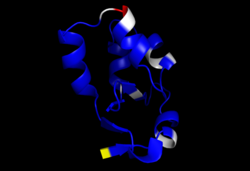CheShift
Topic: Software
 From HandWiki - Reading time: 2 min
From HandWiki - Reading time: 2 min
 | |
| Stable release | 3.0
/ 1 September 2013 |
|---|---|
| Written in | Python, HTML |
| Operating system | Cross-platform |
| Available in | English |
| Type | Bioinformatics |
| License | Free of charge for academic use |
| Website | cheshift |
CheShift-2 (pronounced /tʃeʃɪft/) is an application created to compute 13Cα and 13Cβ protein chemical shifts and to validate protein structures. It is based on quantum mechanics computations of 13Cα and 13Cβchemical shift as a function of the torsional angles (φ, ψ, ω and χ1, χ2) of the 20 amino acids.
CheShift-2 can return a list of theoretical chemical shift values from a PDB file. It also can display a 3D protein model based on an uploaded PDB file and chemical shift values. The 3D protein model is colored using a five color code indicating the differences of the theoretical vs the observed chemical shifts values. The differences between observed and predicted 13Cα and 13Cβ chemical shifts can be used as a sensitive probe with which to detect possible local flaws in protein structures.[1] If both 13Cα and 13Cβ observed chemical shifts are provided CheShift-2 will attempt to provide a list of alternative χ1 and χ2 side-chain torsional angles that will reduce the differences between observed and computed chemical shifts, these values can be used to repair flaws in protein structures.[2]
CheShift-2 can be accessed online at http://www.cheshift.com, or via PyMOL plugin.
See also
Related software
External links
References
- ↑ Martin, O. A., Vila, J. A. and Scheraga, H. A. (2012). "CheShift-2: graphic validation of protein structures". Bioinformatics 28 (11): 1538–1539. doi:10.1093/bioinformatics/bts179. PMID 22495749.
- ↑ Martin O.A. Arnautova Y.A. Icazatti A.A. Scheraga H.A. and Vila J.A. (2013). "A Physics-Based Method to Validate and Repair Flaws in Protein Structures". PNAS 110 (42): 16826–16831. doi:10.1073/pnas.1315525110. PMID 24082119.
 |
40 views | Status: cached on September 02 2024 22:48:22
↧ Download this article as ZWI file
 KSF
KSF